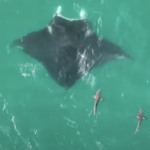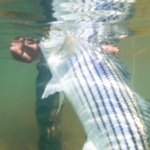
Veteran Florida Guides Concerned About False Albacore
While the ASGA team is extremely proud of the community we’re building with the Guide
Get Involved: Public Comment Deadline is April 15, 2022
By Tony Friedrich
Vice President/Policy Director
This blog will detail everything you need to know about commenting on draft Amendment 7 to the Interstate Fishery Management Plan for Atlantic Striped Bass. We cannot emphasize enough that this your last chance and biggest opportunity to make a difference. Look to the recent victories in the Pebble Mine, the Boundary Waters, and Captains for Clean Water/Everglades Restoration. The conservation-minded public spoke and overwhelmed the opposition. You must do that now.
There isn’t a way to make it easier. We can only try our best to distill the information in an honest way to get all of you to comment. If we don’t include everything, we aren’t doing any favors to striped bass. However, if you only comment on a single issue, then please focus on 4.6.2 Management Program Equivalency, better known as Conservation Equivalency (CE).
We have several podcasts detailing the four major topics. Episodes 35 through 38 focus on Amendment 7. Please listen to these for more clarity.
The state-by-state public hearing schedule can be found here, which includes a mix of in-person and virtual events. We posted the most up to date schedule below. Some of these meetings have changed from virtual to in person. Check the link for the most up to date information. If something changes, we will do our best to make you aware. If you can’t attend a hearing, the public comment period ends on April 15, 2022. Individual emails are what counts the most. Form letters count the least. Send your comment to comments@asmfc.org with the subject line “Draft Amendment 7.” We will be running a raffle again this time. There will be awesome prizes from our best sponsors. Just copy stripercomments@gmail.com in your email to ASMFC and you are entered. It does not matter if you agree with our positions or not. We just want folks to participate in this process.
ASGA has also produced an infographic detailing our positions for easy distribution. It can be found here. We have between now and April 15 to do everything in our power to recover striped bass. It will take all of you, but it can be done. Let’s all pull together and restore striped bass.


Below are the formal positions of the American Saltwater Guides Association on each of the four options in the draft amendment:
4.1 Management Triggers
Tier 1: Fishing Mortality (F) Triggers
Option A: Timeline to Reduce F to the Target
ASGA Supports Sub-option A1 (status quo): Reduce F to a level that is at or below the target within one year.
Option B: F Threshold Triggers
ASGA Supports Sub-option B1 (status quo): If F exceeds the F threshold, the striped bass management program must be adjusted to reduce F to a level that is at or below the target within the timeframe selected under Option A.
Option C: F Target Triggers
ASGA Supports Sub-option C1 (status quo): If F exceeds the F target for two consecutive years and female SSB falls below the SSB target in either of those years, the striped bass management program must be adjusted to reduce F to a level that is at or below the target within the timeframe selected under sub-option A.
Tier 2: Spawning Stock Biomass (SSB) Triggers
Option A: Deadline to Implement a Rebuilding Plan
ASGA Supports Sub-option A2: Two-Year Deadline to Implement a Rebuilding Plan. The Board must implement a rebuilding plan within two years from when an SSB-based management trigger is tripped.
Option B: SSB Threshold Trigger
ASGA Supports Sub-option B1 (status quo): If female SSB falls below the SSB threshold, the striped bass management program must be adjusted to rebuild the biomass to the target level within an established timeframe [not to exceed 10-years].
Option C: SSB Target Trigger
ASGA Supports Sub-option C1 (status quo): If female SSB falls below the target for two consecutive years and the fishing mortality rate exceeds the target in either of those years, the striped bass management program must be adjusted to rebuild the biomass to a level that is at or above the target within an established timeframe [not to exceed 10-years].
Tier 3: Recruitment Triggers
Option A: Recruitment Trigger Definition
ASGA Supports Sub-option A2: The recruitment trigger is tripped when any of the four Juvenile Abundance Indices (JAIs) used in the stock assessment model to estimate recruitment (NY, NJ, MD, VA)11 shows an index value that is below 75% of all values (i.e., below the 25th percentile) in the respective JAI from 1992-2006, which represents a period of high recruitment, for three consecutive years.
Option B: Management Response to Recruitment Trigger
ASGA Supports Sub-option B2. If the recruitment trigger is tripped, an interim F target calculated using the low recruitment assumption is implemented, and if F from the terminal year of the most recent stock assessment is above the interim F target, the striped bass management program must be adjusted to reduce F to the interim F target within one year.
Tier 4: Deferred Management Action
ASGA Supports Option A (status quo): No Deferred Management Action.
If any (or all) of the management triggers are tripped following a benchmark stock assessment or assessment update, the Board is required to respond to that trigger regardless of when the last management action was implemented in response to any management trigger.
4.2.2 Measures to Address Recreational Release Mortality
Option C. Additional Gear Restrictions
ASGA Supports Sub-option C1: Recreational anglers would be prohibited from using any device other than a nonlethal device to remove a striped bass from the water or assist in the releasing of a striped bass.
ASGA Supports Sub-option C2: Striped bass caught on any unapproved method of take would be returned to the water immediately without unnecessary injury.
Option D. Outreach and Education
ASGA Supports Sub-option D2: It is recommended states continue to promote best striped bass handling and release practices by developing public education and outreach campaigns. States should provide updates on public education and outreach efforts in annual state compliance reports. Best practices could include those listed in sub-option D1.
4.4 Rebuilding Plan
4.4.1 Recruitment Assumption for Rebuilding Calculation
ASGA Supports Option B: Rebuild female SSB to the SSB target level by no later than 2029. F rebuild is calculated to achieve the SSB target by no later than 2029 using the low recruitment regime assumption as identified by the change point analysis.
4.4.2 Rebuilding Plan Framework
ASGA Supports Option B: If the 2022 stock assessment results indicate the Amendment 7 measures have less than a 50% probability of rebuilding the stock by 2029 (as calculated using the recruitment assumption specified in Amendment 7) and if the stock assessment indicates at least a 5% reduction in removals is needed to achieve F rebuild, the Board may adjust measures to achieve F rebuild via Board action.
4.6.2 Management Program Equivalency (Conservation Equivalency)
Option B. Restrict the Use of Conservation Equivalency (CE) Based on Stock Status
ASGA Supports Sub-option B1-a: CE programs would not be approved when the stock is at or below the biomass threshold (i.e., overfished). CE programs would not be considered until a subsequent stock assessment indicates stock biomass is above the threshold level.
Option C. Precision Standards for MRIP Estimates Used in Conservation Equivalency Proposals
ASGA Supports Sub-option C3: CE proposals would not be able to use Marine Recreational Information Program (MRIP) estimates associated with a percent standard error (PSE) exceeding 30%.
Option D. Conservation Equivalency Uncertainty Buffer for Non-Quota Managed Fisheries
ASGA Supports Sub-option D2: Proposed CE programs for non-quota managed fisheries would be required to include an uncertainty buffer of 25%.
Option E. Definition of Equivalency for CE Proposals with Non-Quota Managed Fisheries
ASGA Supports Sub-option E2: the percent reduction/liberalization projected for the FMP standard at the state-specific level.
There it is! Please be on the lookout for a follow-up blog in the next twenty-four hours that explains our rationale for each of these positions. Thanks for reading!

While the ASGA team is extremely proud of the community we’re building with the Guide

Feature Image: A false albacore being landed off Jupiter Florida by the Cheeky Fishing team,

Feature Photo: “Best Practices for Fishing Cobia Around Manta Rays” The Florida Manta Project is

We caught this article a few days ago. Here’s the summary: Maryland striped bass commercial
We rely on our members and donations to keep fighting for a sustainable tomorrow in marine conservation.
By using this website, you agree to our use of cookies. We use cookies to provide you with a great experience and to help our website run effectively. To learn more, please review our privacy policy.
7 Responses
An honest reading points to an ongoing attempt to avoid the necessary step to outlaw any deliberate taking of breeding age bass. The longer we wait, the longer the ultimate moratorium will of necessity be in place. More fine print will not change that reality.
To protect this resource we must all do our part to encourage our shared Bass population . The tide must be turned by all of us to support this treasured species.
Unfortunately, an option for moratorium was ruled out in a previous meeting. Public comment is ONLY considered if it is in relation to the proposed options. Vetting frustrations with management only dilutes the public comment period’s impact. Even if it may be the solution, mentions of moratorium would likely make your comment invalid. :/
We should be looking into additional options regarding the TROPHY season. New regulations should be implemented regarding migrating fish. So many of these fish are caught each and every year before they have the chance to spawn. Trophy season should be seen as catch and release only for fish above that 30 or 35 inch mark.
Large Charter outings during this season is a huge stream of revenue in each and every state on the Northeast Coast, and I do understand it would be hard to cut out in its entirety. Trolling is one of the most common ways these larger fish are caught, and it is very rough on the bass that are left dragging behind the boat while the angler pulls the fish in. This highly raises the mortality rate with these fish that are released back into the water. There needs to also be more regulations implemented regarding how an angler treats the fish while out of the water and during the revival process. I see too many anglers that are not educated regarding this process and it too leads to a higher mortality rate.
Look at the Red Drum, a perfect example of how introducing more regulations was able to bring back HUGE numbers of these fish, I do think that it would be worth it to look into also adding a slot for rockfish. Would be open to a slot for the entire season but believe it would only be necessary during migration months depending on the state you reside in.
To protect this resource we must all do our part to encourage our shared Bass population . The tide must be turned by all of us to support this treasured species. This is what America is about – listen to us